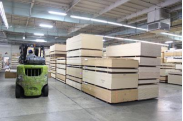Has your table split in half right before the holidays when you’re going to have friends and family over? Here’s what’s going on…
Wood moves.
DUH. But HOW it moves matters, if you want your woodworking projects to stand the test of time. More importantly, can you take steps to reduce the potential for problems down the road?
Why, yes; yes you can. But let’s understand something first. Wood isn’t like sponge. A sponge loses or gains moisture from the air around it. So does wood. But a sponge handles that moisture evenly. Wood does not: depending upon the direction and orientation of the grain, it will take or give moisture unevenly. We’ll come right back to that; first…
Kiln Drying
When wood is kiln-dried from green (full of moisture) to dry (usually 6-8% moisture content) it shrinks in three directions:
· Longitudinal Shrinkage is in the length of the board, and it is almost insignificant in any wood species. PLYWOOD takes advantage of this fact by placing succeeding plies perpendicular to each other. So the resistance to shrinking in length of one ply (longitudinal) restricts the tendency of the adjacent plies to shrink tangentially. That’s why plywood is so stable.
· Tangential Shrinkage is across the face of the board, and it can be significant. If you’ve seen table tops or floorboards split open in the dry winter and squeeze tight in the humid air of summer, you’ve witnessed tangential shrinkage. This can also result in buckling, as too much wood is confined in a space designed when the wood was much drier. Of the three, Tangential Shrinkage is the most significant, between 6 and 10 percent in most species (some as low as 3%, some as high as 12%).
· Radial Shrinkage is the third dimension: the thickness of the board. Typical hardwood ranges fall between 3% and 5% of shrinkage.
There is an art to kiln-drying lumber, and Valencia Lumber looks to experts to take care of this valuable resource properly.
What about after it leaves the kiln?
(Don’t you hate the kids who sit right up front?) The numbers above refer to shrinkage in the drying process of woods and don’t correlate to how much lumber is going to change after drying. For every species, there is information available about the ratio of Tangential-to-Radial shrinkage (T/R), which is helpful, and boring, and available elsewhere, such as The Wood Database.
Quartersawn lumber has a very low T/R ratio, about 1/1. The thickness of the board is doing all the swelling and shrinking; the face of the board is barely moving. That’s why quartersawn lumber is so desirable for surfaces that need to stay reliably flat. (Rift-sawn is similarly stable, and avoids the ray-fleck and figure that can be exhibited in quartered lumber).
Now picture a plain-sawn (aka flatsawn) board. The grain toward the outside edges angles sharply away from the face, like Rift or Quartered lumber. But in the middle, the angle of the grain to the face of the board is much shallower, in some places almost flat. This variation in grain results in variations in the transfer of moisture over the life of that board, resulting in unpredictable movement.
So, to the question of how to avoid this problem:
· Buy from a reputable supplier (such as our lumber yard) whose hardwood is dried properly (6 to 8 percent moisture content).
· Consider Quarter-Sawn or Rift-Sawn lumber when available.
· Let your lumber acclimate to the environment it will reside in, when possible, before fabrication. (Build it in Louisiana in August and ship it to North Dakota in the winter…).
· Store and handle your lumber properly, avoiding extremes of humidity levels. (If you store your lumber in the sauna… just sayin’).
· MOST IMPORTANT OF ALL: use proper wood joinery methods. The internet is overflowing with helpful advice; that is not the expertise of Valencia Lumber and Panel. Seek the advice of professionals.



